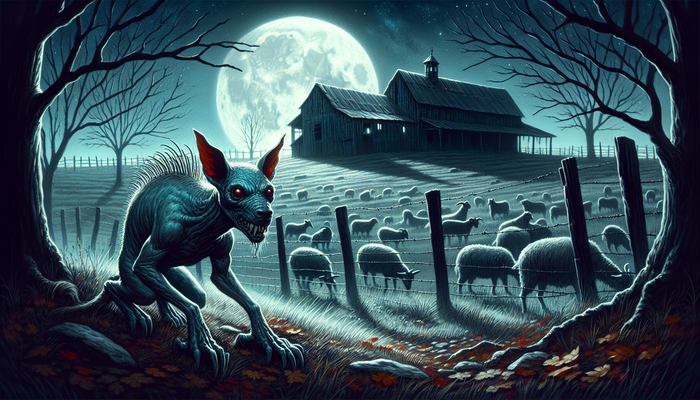Exploring the Tiger Snakes in Tasmania's Folklore

By James Roberts, Cryptozoologist
The tiger snake, with its striking bands and potent venom, has long captured the imagination of both locals and visitors to this island state. But there's so much more to these serpents than meets the eye. Their story is one of adaptation, survival, and a complex relationship with the human inhabitants of Tasmania. Join me as we unravel the mysteries and myths surrounding these enigmatic reptiles, and explore their place in the rich tapestry of Tasmanian folklore.
Picture this: a sun-dappled forest floor, the air thick with the scent of eucalyptus, and suddenly, a flash of yellow and black. Your heart races as you realize you've just encountered one of Tasmania's most infamous residents - the tiger snake. For many, this scenario is the stuff of nightmares. But for those of us who have spent years studying these remarkable creatures, it's a moment of pure excitement.
The tiger snake, scientifically known as Notechis scutatus, is a creature that embodies both fear and fascination in Tasmania's folklore. It's an animal that has been vilified and revered, hunted and protected, misunderstood and marveled at. In this exploration, we'll peel back the layers of myth and misconception to reveal the true nature of these snakes and their significant role in Tasmanian culture and ecology.
As we embark on this journey, we'll examine not just the biological characteristics of tiger snakes, but also their historical interactions with humans, their cultural significance, and the myriad myths that have sprung up around them. From the rugged coastlines to the misty highlands, from Aboriginal Dreamtime stories to settler's tales of terror, the tiger snake has left its mark on every aspect of Tasmanian life.
So, tighten your bootlaces, keep your eyes peeled, and let's venture into the world of Tasmania's tiger snakes. I promise you, by the end of this journey, you'll see these creatures in a whole new light.
The Tiger Snake: A Biological Overview
Description and Habitat
Let's start with the basics. The tiger snake is a sight to behold, a perfect example of nature's artistry. Its name comes from the distinctive banding pattern that adorns many individuals - alternating stripes of yellow and black that ripple down the length of their muscular bodies. However, don't be fooled into thinking all tiger snakes look alike. One of the most fascinating aspects of these snakes is their incredible variability in coloration.
In my years of studying these creatures, I've encountered tiger snakes in an astonishing array of colors and patterns. Some sport the classic yellow and black bands, while others are a uniform jet black. I've seen individuals with olive green bodies and cream-colored bands, and even some with a reddish tinge to their scales. This variability isn't just a quirk of nature; it's a testament to the tiger snake's adaptability, allowing them to blend into a variety of habitats.
Speaking of habitats, tiger snakes are remarkably versatile in their choice of homes. While they have a preference for wetlands, marshes, and coastal regions, they're not picky. I've encountered them in dense forests, open grasslands, and even rocky outcrops. In Tasmania, you're just as likely to find a tiger snake basking on a sun-warmed rock by the sea as you are to stumble upon one in a mountain meadow.
Their ability to thrive in such diverse environments is one of the keys to their success. Tasmania's landscape is a patchwork of different habitats, from the temperate rainforests of the west to the dry sclerophyll forests of the east, and tiger snakes have managed to carve out a niche in almost all of them.
One particularly interesting habitat that tiger snakes have colonized is the many small islands that dot the coast of Tasmania. These island populations have often evolved unique characteristics, which we'll explore in more depth later. For now, suffice it to say that the tiger snake's ability to swim has allowed it to become one of the most widespread reptiles in the region.
Diet and Behavior
Now, let's talk about what makes a tiger snake tick - or more accurately, what makes it hiss. These snakes are predators, and impressive ones at that. Their diet is as varied as their habitat, encompassing a wide range of prey species.
In my observations, I've seen tiger snakes feed on everything from frogs and fish to small mammals and birds. They're opportunistic hunters, adapting their diet to whatever prey is most abundant in their particular habitat. In wetland areas, frogs and tadpoles make up a significant portion of their diet. In more forested regions, they might focus on small mammals like mice and rats.
One of the most fascinating aspects of tiger snake behavior is their hunting technique. Unlike some snakes that rely on ambush tactics, tiger snakes are active hunters. They'll patrol their territory, using their keen sense of smell to track down prey. When they detect a potential meal, they'll approach stealthily, then strike with lightning speed.
Their venom plays a crucial role in their hunting strategy. Tiger snake venom is a potent cocktail of neurotoxins and coagulants, designed to quickly immobilize and kill their prey. It's this same venom that makes them so dangerous to humans, but we'll delve into that a bit later.
Another interesting behavioral trait of tiger snakes is their ability to climb. While they're primarily terrestrial, I've observed tiger snakes scaling trees and even buildings in search of prey or suitable basking spots. This climbing ability, combined with their swimming prowess, makes them incredibly adaptable predators.
Venom and Its Effects
Now, we come to the aspect of tiger snakes that has perhaps contributed most to their fearsome reputation - their venom. Make no mistake, tiger snakes are among the most venomous snakes in the world. Their venom is a complex mixture of toxins, each playing a specific role in subduing prey and, unfortunately, causing severe symptoms in human bite victims.
The primary components of tiger snake venom are neurotoxins, which attack the nervous system, and coagulants, which affect blood clotting. When injected into a prey animal (or an unfortunate human), these toxins can cause a range of symptoms including pain, sweating, difficulty breathing, and paralysis. In severe cases, untreated bites can lead to death.
However, it's important to note that the potency of venom can vary between individual snakes and even between populations. For example, the tiger snakes found on some of Tasmania's offshore islands have been found to have particularly potent venom, possibly as an adaptation to their unique prey.
Historically, tiger snake bites were a significant cause of death in Tasmania. In the early days of European settlement, when medical care was limited and antivenom non-existent, a bite from a tiger snake was often a death sentence. However, the development of effective antivenom in the 1930s dramatically reduced the fatality rate from tiger snake bites.
Today, while tiger snake bites are still considered a medical emergency, deaths are extremely rare. In fact, there have been only three recorded deaths from snake bites in Tasmania since 1948. This is a testament not only to the effectiveness of modern medical treatments but also to increased public awareness and education about snake safety.
As we delve deeper into the history and folklore surrounding tiger snakes, it's crucial to keep this biological context in mind. Understanding the true nature of these animals - their adaptability, their hunting behavior, and yes, their venom - is key to separating fact from fiction in the many stories that have grown up around them.
Historical Context: European Settlement and the Fear of Snakes
Arrival of European Settlers
To truly understand the place of tiger snakes in Tasmanian folklore, we need to step back in time to the early days of European settlement. The year was 1803 when the first British settlers arrived on the shores of Van Diemen's Land, as Tasmania was then known. These newcomers brought with them not just their possessions and hopes for a new life, but also their fears and preconceptions about the natural world.
For many of these early settlers, snakes were creatures of biblical evil, associated with the serpent in the Garden of Eden. The sight of a large, venomous snake like the tiger snake would have been terrifying to say the least. Add to this the unfamiliarity of the Australian landscape, with its strange animals and plants, and you have a recipe for fear and misunderstanding.
One of the earliest recorded encounters between European settlers and tiger snakes occurred just hours after the arrival of the First Fleet in Sydney. While this incident didn't take place in Tasmania, it set the tone for future interactions between settlers and snakes across Australia. According to reports, a sailor was bitten by a snake, believed to be a tiger snake, and died shortly after. This event, occurring so soon after arrival, must have seemed like an ominous sign to the newcomers.
In Tasmania, encounters with tiger snakes were frequent and often frightening for the settlers. The snakes were common in the areas where Europeans chose to establish their farms and settlements, leading to numerous close calls and, tragically, some fatalities. These encounters quickly cemented the tiger snake's reputation as a dangerous and deadly creature.
One particularly influential figure in the early European response to tiger snakes was Lady Jane Franklin, wife of Sir John Franklin, who served as Lieutenant-Governor of Van Diemen's Land from 1837 to 1843. Lady Franklin was known for her interest in natural history, but she also harbored a deep fear of snakes. This fear led her to take drastic action that would have long-lasting consequences for Tasmania's snake populations.
In the 1830s, Lady Franklin established a bounty system for snake killing. She offered a reward of one shilling for every snake killed and presented to the authorities. This bounty was a significant sum at the time, equivalent to about a day's wages for a laborer. The result was a widespread campaign of snake killing that saw thousands of tiger snakes and other species slaughtered.
Records from the time indicate that in just one year, over 8,000 snakes were killed under this bounty system. While Lady Franklin's intentions may have been to make the colony safer for settlers, the ecological impact of this mass killing was significant and long-lasting.
The bounty system had several unintended consequences. Firstly, it reinforced the settlers' fear of snakes, portraying them as a menace that needed to be eradicated rather than a natural part of the ecosystem. Secondly, it disrupted the natural balance of the environment. Tiger snakes play a crucial role in controlling rodent populations, and their sudden decline likely led to an increase in rats and mice, which in turn caused problems for the settlers' crops and food stores.
Interestingly, despite the large number of snakes killed, the bounty system did little to actually reduce snake populations in the long term. Snakes are remarkably resilient and adaptable creatures, and the tiger snake population was able to bounce back relatively quickly. This resilience only added to the snake's fearsome reputation among settlers, who saw it as an almost supernatural foe that couldn't be defeated.
Cultural Impact of Fear
The fear of tiger snakes that took root during these early years of settlement had a profound and lasting impact on Tasmanian culture. It shaped how people interacted with the natural environment, influenced land management practices, and gave rise to a rich body of folklore and myth.
One of the most immediate impacts was on how settlers approached the task of clearing land for agriculture. The presence of tiger snakes made this already difficult work even more dangerous. Settlers would often burn large areas of bush to clear land, partly as a way to remove snake habitat. This practice not only destroyed native vegetation but also disrupted the entire ecosystem, affecting many other species beyond just the snakes.
The fear of snakes also influenced how people moved through the landscape. Settlers developed a heightened awareness of their surroundings, always on the lookout for the telltale signs of a snake. This vigilance became a part of Tasmanian bush culture, passed down through generations. Even today, many Tasmanians instinctively scan the ground when walking through long grass or leaf litter, a habit ingrained by centuries of living alongside tiger snakes.
The constant threat of snakebite also led to the development of various folk remedies and first aid techniques. Some of these, like the use of tourniquets, we now know to be ineffective or even harmful. Others, like the practice of keeping still to slow the spread of venom, have stood the test of time and remain part of modern snakebite first aid protocols.
Perhaps the most significant cultural impact of the fear of tiger snakes was the development of a rich body of folklore. Stories about encounters with giant snakes, miraculous escapes from certain death, and the supposed aggressive nature of tiger snakes became common currency in Tasmanian society. These tales, passed down through generations, often exaggerated the size, aggression, and deadliness of tiger snakes.
One common myth that emerged during this time was the idea that tiger snakes could chase people. In reality, tiger snakes, like most snakes, prefer to avoid confrontation with humans and will usually try to escape if given the chance. However, the speed and agility of tiger snakes, combined with the panic of a surprised human, could easily give the impression of a snake in pursuit.
Another persistent myth was the belief that tiger snakes were inherently aggressive and would go out of their way to attack humans. This belief likely arose from incidents where snakes, cornered or threatened, displayed defensive behavior that was misinterpreted as aggression. The truth is that tiger snakes, like most animals, only 'attack' as a last resort when they feel threatened and unable to escape.
These myths and misconceptions, born out of fear and lack of understanding, have proven remarkably persistent. Even today, with all our scientific knowledge about snake behavior, these old beliefs continue to color many people's perceptions of tiger snakes.
The cultural impact of this fear extended beyond just attitudes towards snakes. It contributed to a broader view of the Tasmanian wilderness as a dangerous, hostile environment that needed to be tamed and controlled. This perspective had far-reaching consequences for Tasmania's natural environment, influencing everything from land management practices to conservation policies.
However, it's important to note that not all cultural impacts were negative. The presence of tiger snakes also fostered a respect for the power of nature among many Tasmanians. It contributed to a culture of bush awareness and safety that has likely saved many lives over the years. And for some, the ability to safely navigate snake country became a point of pride, a testament to their bush skills and knowledge.
As we move forward in our exploration of tiger snakes in Tasmanian folklore, it's crucial to keep this historical context in mind. The fear and misunderstanding that took root in these early years of settlement laid the foundation for many of the myths and legends that we'll explore in the next section. But as we'll see, the story of tiger snakes in Tasmania is far more complex and nuanced than these early settlers could have imagined.
Folklore and Myths: The Tiger Snake in Tasmanian Culture
Symbolism in Local Narratives
As we delve deeper into the world of Tasmanian folklore, the tiger snake emerges as a powerful symbol, embodying a range of meanings that reflect the complex relationship between humans and the natural world. In the stories and legends that have been passed down through generations, the tiger snake is far more than just a dangerous reptile - it's a creature of myth and magic, fear and respect.
One of the most prevalent symbolic roles of the tiger snake in Tasmanian folklore is as a representation of danger and cunning. In many local narratives, the tiger snake is portrayed as a clever adversary, always one step ahead of human attempts to control or eradicate it. This portrayal reflects not only the snake's actual ability to thrive despite human persecution but also the settlers' frustration at their inability to rid themselves of this perceived threat.
I've heard countless stories from old-timers about legendary tiger snakes that seemed almost supernatural in their ability to evade capture or survive against all odds. One tale that's particularly stuck with me is about a massive tiger snake that supposedly lived in the Florentine Valley for decades, growing to monstrous size and developing an uncanny ability to predict and avoid human traps. While the truth of such stories is questionable, they speak to the deep impression that tiger snakes have made on the Tasmanian psyche.
Another common theme in tiger snake folklore is the idea of the snake as a guardian or protector of the land. This concept, which has roots in both Aboriginal and European traditions, portrays the tiger snake as a kind of spiritual custodian, defending the wilderness against human encroachment. In some stories, tiger snakes are said to appear to warn people away from sacred or dangerous places.
This guardian role is often linked to the snake's association with water. Tiger snakes are excellent swimmers and are often found near creeks, rivers, and wetlands. In folklore, they're sometimes depicted as protectors of water sources, punishing those who pollute or misuse these precious resources. This symbolism reflects both the ecological importance of water in Tasmania's often drought-prone environment and the vital role that tiger snakes play in riparian ecosystems.
The tiger snake also features prominently in stories about human hubris and the dangers of underestimating nature. Many Tasmanian folktales revolve around characters who ignore warnings about snakes, only to meet with dire consequences. These cautionary tales serve not only to warn about the physical danger of snakes but also to reinforce a broader message about the importance of respecting the natural world.
Interestingly, as attitudes towards conservation have evolved over the years, so too has the symbolism of the tiger snake in some narratives. In more recent times, I've noticed a trend towards portraying the tiger snake as a symbol of Tasmania's unique and precious biodiversity. Stories that once might have ended with the slaying of a monstrous snake now often conclude with a message about the importance of preserving these creatures and their habitats.
The Dual Nature of the Tiger Snake
One of the most fascinating aspects of tiger snake folklore is the way it reflects the dual nature of these creatures in the Tasmanian imagination. On one hand, they are feared as deadly killers, capable of ending a human life with a single bite. On the other, they are respected and even admired for their beauty, strength, and resilience.
This duality is perhaps best exemplified by the contrasting ways in which different cultures in Tasmania have perceived and interacted with tiger snakes. For many European settlers and their descendants, the tiger snake was primarily an object of fear, a dangerous pest to be eliminated. This fear-based perspective gave rise to many of the negative myths and misconceptions about tiger snakes that persist to this day.
However, for Tasmania's Aboriginal peoples, the tiger snake held a very different significance. In many Aboriginal cultures, snakes in general, and tiger snakes in particular, are seen as important spiritual beings, often associated with creation stories and the shaping of the land. The tiger snake's ability to shed its skin made it a powerful symbol of renewal and transformation.
In some Aboriginal stories, the tiger snake is portrayed as a trickster figure, using its cunning to outsmart other animals or even humans. These stories often carry important moral or practical lessons about living in harmony with the natural world. The respect for tiger snakes in Aboriginal culture is reflected in traditional practices that seek to avoid conflict with these animals rather than attempting to eliminate them.
This more nuanced view of tiger snakes as complex, multifaceted creatures is increasingly being recognized and adopted by the broader Tasmanian community. As our understanding of ecology and the importance of biodiversity has grown, so too has appreciation for the tiger snake's role in maintaining healthy ecosystems.
I've witnessed this shift in perspective firsthand during my years of research and public education work. Where once I might have encountered almost universal fear and hostility towards tiger snakes, I now often find curiosity and a desire to understand these fascinating animals. Many Tasmanians, while still maintaining a healthy respect for the danger posed by tiger snakes, now also see them as an integral and valuable part of the island's natural heritage.
This evolving perception is reflected in contemporary Tasmanian art, literature, and popular culture, where tiger snakes are increasingly portrayed in a more positive or nuanced light. They've become a symbol of Tasmania's wild places, a creature that embodies both the beauty and the danger of the island's rugged landscapes.
The dual nature of the tiger snake in Tasmanian folklore - feared yet respected, dangerous yet valuable - mirrors the complex relationship between humans and the natural world. As we continue to grapple with issues of conservation and coexistence with wildlife, the tiger snake stands as a powerful reminder of the need to balance human needs with the preservation of nature.
Aboriginal Significance: The Tiger Snake in Indigenous Culture
Cultural Narratives and Beliefs
As we turn our attention to the Aboriginal significance of tiger snakes, we enter a realm of deep spiritual connection and ancient wisdom. The Indigenous peoples of Tasmania, who have lived on this island for tens of thousands of years, have developed a rich and complex relationship with the tiger snake, one that is woven into the very fabric of their culture and belief systems.
In many Aboriginal Dreamtime stories, snakes play a crucial role in the creation of the land and its features. The tiger snake, with its distinctive markings and powerful presence, often features as a key character in these narratives. One story that has always fascinated me tells of a great tiger snake that carved out the rivers and valleys of Tasmania with its sinuous body as it traveled across the land. This tale not only explains the origin of the island's geography but also emphasizes the power and importance of the tiger snake in shaping the world.
Another common theme in Aboriginal stories about tiger snakes is their association with water. Many Indigenous groups see the tiger snake as a guardian of water sources, responsible for ensuring the flow of rivers and the filling of waterholes. This belief reflects the ecological reality of tiger snakes' preference for wetland habitats, but it also imbues these creatures with a sacred responsibility for maintaining the life-giving water that is so crucial in Australia's often arid environment.
The tiger snake's ability to shed its skin has made it a powerful symbol of renewal and rebirth in many Aboriginal cultures. This process of transformation is often linked to spiritual practices and ceremonies, with the shedding of the snake's skin seen as a metaphor for personal growth and the shedding of old ways or negative influences.
In some Aboriginal traditions, the tiger snake is also associated with healing practices. The venom of the snake, which Western science now recognizes as having potential medicinal properties, was sometimes used in traditional medicine. While the specifics of these practices are often kept secret within Aboriginal communities, it's clear that the tiger snake was seen as a source of both danger and potential healing power.
The rainbow serpent, a central figure in many Aboriginal creation myths across Australia, is sometimes associated with the tiger snake in Tasmanian Aboriginal lore. While the rainbow serpent is typically depicted as a much larger, more fantastical creature, some of its attributes - such as its connection to water and its role in shaping the land - overlap with those of the tiger snake. This connection further emphasizes the important place that tiger snakes hold in Aboriginal cosmology.
Traditional Ecological Knowledge
Beyond these spiritual and mythological aspects, Aboriginal cultures have also developed a deep practical knowledge of tiger snakes and their behavior. This traditional ecological knowledge, passed down through generations, reflects a sophisticated understanding of these animals and their place in the ecosystem.
One aspect of this knowledge that has always impressed me is the Aboriginal understanding of tiger snake behavior and habitat preferences. Through careful observation over thousands of years, Indigenous peoples developed a nuanced awareness of where and when one might encounter a tiger snake, how to avoid conflict with these animals, and how to coexist safely with them.
For example, many Aboriginal people can read subtle signs in the environment that indicate the presence of tiger snakes. They understand the types of habitats that these snakes prefer, the times of day when they are most active, and the behaviors that might provoke a defensive response from a snake. This knowledge allows them to move through snake country with a level of safety and confidence that early European settlers, lacking this traditional knowledge, could not match.
Aboriginal people also recognized the ecological role of tiger snakes long before Western science caught up. They understood that these snakes played an important part in controlling populations of small mammals and other prey species, helping to maintain a balance in the ecosystem. This understanding led to a more tolerant attitude towards tiger snakes, seeing them as necessary components of a healthy environment rather than as pests to be eliminated.
The importance of respecting wildlife, including potentially dangerous animals like tiger snakes, is a central tenet of many Aboriginal cultures. This respect is not born out of fear, but out of a deep understanding of the interconnectedness of all living things. In the Aboriginal worldview, humans are not separate from or superior to nature, but are part of it, with responsibilities to care for and maintain the natural world.
This perspective has led to the development of various practices and protocols for interacting with tiger snakes. For instance, many Aboriginal groups have specific ways of moving through areas where tiger snakes are known to live, designed to minimize the risk of surprising a snake and provoking a defensive response. There are also traditional methods for safely encouraging a snake to move away from human habitation without harming it.
One practice that I find particularly interesting is the use of smoke to deter snakes. Some Aboriginal groups would burn certain types of vegetation to create a smoke that tiger snakes find unpleasant, effectively creating a natural repellent. This method allows for coexistence with snakes without resorting to killing them, reflecting the Aboriginal principle of taking only what is needed from the environment and avoiding unnecessary harm to other creatures.
The Aboriginal approach to living with tiger snakes offers a stark contrast to the fear-based responses of many European settlers. Where settlers saw a deadly threat to be eliminated, Aboriginal people saw a powerful and important creature to be respected and, when necessary, carefully avoided. This difference in perspective has had profound implications for how tiger snakes have been treated and perceived in Tasmania over the centuries.
As we move forward in our exploration of tiger snakes in Tasmanian folklore, it's crucial to recognize and honor this deep well of Aboriginal knowledge and tradition. The Indigenous perspective on tiger snakes provides a valuable counterpoint to European-derived myths and fears, offering a more balanced and ecologically sound way of understanding and coexisting with these remarkable animals.
In recent years, there has been growing recognition of the value of traditional Aboriginal ecological knowledge in conservation efforts. Scientists and wildlife managers are increasingly working with Aboriginal communities to incorporate traditional knowledge into snake management strategies. This collaboration not only leads to more effective conservation outcomes but also helps to preserve and honor the rich cultural heritage associated with tiger snakes.
Modern Encounters: The Reality of Tiger Snakes Today
Current Snakebite Statistics and Incidents
As we transition from the rich tapestry of historical and cultural perspectives on tiger snakes, it's crucial to ground our exploration in the reality of modern-day encounters. Despite the fears and myths that have surrounded these creatures for centuries, the truth is that serious incidents involving tiger snakes are relatively rare in Tasmania today.
Let's look at the numbers. According to recent statistics, tiger snakes account for about 17% of identified snakebite victims in Australia. However, it's important to note that this figure covers all of Australia, not just Tasmania. In Tasmania specifically, snakebite incidents are even less common, thanks in part to the cooler climate and the fact that there are only three venomous snake species on the island.
Between 2005 and 2015, there were 119 confirmed envenomations from tiger snakes across Australia, resulting in four deaths. This might sound alarming, but when you consider the population size and the number of potential encounters, it's actually a remarkably low figure. In Tasmania, the statistics are even more reassuring. Since 1948, there have been only three recorded deaths from snakebite in Tasmania, and not all of these were necessarily from tiger snakes.
One of the most recent and widely publicized incidents occurred in January 2020, when a 79-year-old farmer tragically died after being bitten multiple times by a tiger snake on his property in Oatlands, central Tasmania. This incident, while tragic, was the first snakebite fatality in Tasmania in over 40 years, highlighting just how rare such occurrences are.
It's worth noting that most snakebites occur when people attempt to handle or kill snakes. In the case of the Oatlands farmer, it was reported that he had been bitten while attempting to remove the snake from his property. This underscores a crucial point that I always emphasize in my educational work: the best way to avoid a snakebite is to leave snakes alone.
Another factor contributing to the low fatality rate from tiger snake bites is the availability and effectiveness of antivenom. The development of tiger snake antivenom in the 1930s was a game-changer, dramatically reducing the death rate from bites. Today, every major hospital in Tasmania stocks tiger snake antivenom, and medical professionals are well-trained in its use.
Modern medical protocols for treating snakebite have also greatly improved survival rates. The use of pressure immobilization bandaging, when applied correctly, can significantly slow the spread of venom through the body, buying crucial time to reach medical care. Additionally, advances in supportive care, such as mechanical ventilation for patients experiencing respiratory paralysis, have further improved outcomes for snakebite victims.
It's also worth noting that not all bites from tiger snakes result in envenomation. Snakes have control over whether they inject venom when they bite, and many defensive bites are "dry" - delivered without venom. However, it's crucial to treat every snake bite as potentially venomous and seek immediate medical attention.
Public Perception and Education
Despite the relatively low risk of serious injury or death from tiger snake encounters, public perception of these animals often doesn't align with this reality. Fear of snakes remains common in Tasmania, as it does in many parts of the world. This fear, while understandable given the potential danger of a bite, is often disproportionate to the actual risk.
In my years of working to educate the public about snakes, I've encountered a wide range of attitudes. Some people maintain an almost paralyzing fear of snakes, refusing to venture into areas where they might encounter one. Others, particularly those who have grown up in rural areas, have a more matter-of-fact approach, respecting the danger but not letting it overly impact their daily lives.
Interestingly, I've noticed a generational shift in attitudes towards tiger snakes. Younger Tasmanians, who have grown up with more exposure to environmental education, often show a greater interest in and appreciation for these animals. They're more likely to see tiger snakes as an important part of the ecosystem rather than as a threat to be eliminated.
This shift in perception is due in large part to increased education efforts. Schools in Tasmania now often include snake awareness as part of their curriculum, teaching children about the role of snakes in the ecosystem and how to safely coexist with them. Many parks and wildlife centers offer educational programs about local snake species, allowing people to learn about these animals in a safe, controlled environment.
One of the most effective educational tools I've encountered is the use of live snake demonstrations. These events, conducted by trained professionals, allow people to observe tiger snakes up close and learn about their behavior and ecology. While always conducted with strict safety measures in place, these demonstrations can be transformative, helping to replace fear with fascination and respect.
Another important aspect of public education is teaching people how to reduce the risk of snake encounters around their homes. Simple measures like keeping grass short, removing piles of debris that might serve as snake habitat, and sealing entry points into buildings can significantly reduce the likelihood of unwanted snake encounters. By empowering people to take these preventative steps, we can help foster a sense of control and reduce unnecessary fear.
It's also crucial to educate people about what to do if they do encounter a snake. The key message is always the same: leave the snake alone and it will almost certainly leave you alone. Most snake bites occur when people try to kill or capture snakes, so simply backing away and allowing the snake to retreat is the safest course of action.
In cases where a snake needs to be removed from an area where it poses a risk to people, it's important to call a professional snake catcher. These trained individuals can safely capture and relocate snakes without putting themselves or the animal at risk. Many local councils and wildlife services maintain lists of licensed snake catchers who can be called upon in such situations.
From Bigfoot to UFOs: Hangar 1 Publishing Has You Covered!
Explore Untold Stories: Venture into the world of UFOs, cryptids, Bigfoot, and beyond. Every story is a journey into the extraordinary.
Immersive Book Technology: Experience real videos, sights, and sounds within our books. Its not just reading; its an adventure.



























